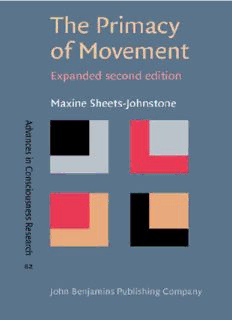
The Primacy of Movement PDF
Preview The Primacy of Movement
The Primacy of Movement Advances in Consciousness Research (AiCR) Provides a forum for scholars from different scientific disciplines and fields of knowledge who study consciousness in its multifaceted aspects. Thus the Series includes (but is not limited to) the various areas of cognitive science, including cognitive psychology, brain science, philosophy and linguistics. The orientation of the series is toward developing new interdisciplinary and integrative approaches for the investigation, description and theory of consciousness, as well as the practical consequences of this research for the individual in society. From 1999 the Series consists of two subseries that cover the most important types of contributions to consciousness studies: Series A: Theory and Method. Contributions to the development of theory and method in the study of consciousness; Series B: Research in Progress. Experimental, descriptive and clinical research in consciousness. This book is a contribution to Series A. For an overview of all books published in this series, please see http://benjamins.com/catalog/aicr Editor Maxim I. Stamenov Bulgarian Academy of Sciences Editorial Board David J. Chalmers Steven Laureys Australian National University University of Liège Axel Cleeremans George Mandler Université Libre de Bruxelles University of California at San Diego Gordon G. Globus John R. Searle University of California Irvine University of California at Berkeley Christof Koch Petra Stoerig California Institute of Technology Universität Düsseldorf Stephen M. Kosslyn Harvard University Volume 82 The Primacy of Movement. Expanded second edition by Maxine Sheets-Johnstone The Primacy of Movement Expanded second edition Maxine Sheets-Johnstone University of Oregon John Benjamins Publishing Company Amsterdam / Philadelphia TM The paper used in this publication meets the minimum requirements of 8 American National Standard for Information Sciences – Permanence of Paper for Printed Library Materials, ansi z39.48-1984. Library of Congress Cataloging-in-Publication Data Sheets-Johnstone, Maxine. The primacy of movement / Maxine Sheets-Johnstone. -- Expanded 2nd ed. p. cm. (Advances in Consciousness Research, issn 1381-589X ; v. 82) Includes bibliographical references and index. 1. Movement (Philosophy) 2. Movement, Psychology of. I. Title. B105.M65S44 2011 116--dc22 2011011681 isbn 978 90 272 5218 0 (Hb ; alk. paper) isbn 978 90 272 5219 7 (Pb ; alk. paper) isbn 978 90 272 8677 2 (Eb) © 2011 – John Benjamins B.V. No part of this book may be reproduced in any form, by print, photoprint, microfilm, or any other means, without written permission from the publisher. John Benjamins Publishing Co. · P.O. Box 36224 · 1020 me Amsterdam · The Netherlands John Benjamins North America · P.O. Box 27519 · Philadelphia pa 19118-0519 · usa To Dmitri and Kevin with immeasurable love and with gratitude for enriching my life immeasurably Table of contents Preface to the expanded second edition xiii Acknowledgments xv Introduction xvii Notes xxxii section i Foundations chapter 1 Neandertals 3 1. Introduction 3 2. “Remarkable mental adaptations” 5 3. “Symbolic behavior” 7 4. Deepened understandings of the symbolic 12 5. Animate form: Theoretical clarifications 18 6. Animate form: Neandertals 22 Notes 32 chapter 2 – part i Consciousness: A natural history 37 1. Introduction 37 2. Reasons for critically questioning the question 38 3. Life and its definitions: A question of animation and justification 44 4. Corporeal consciousness: A matter of knowing 48 5. To the things themselves: Corporeal matters of fact 55 6. From corporeal matters of fact to corporeal consciousness 62 7. Implications 67 Glossary 69 Notes 71 chapter 2 – part ii Consciousness: An Aristotelian account 77 1. Introduction 77 2. Burnyeat’s claim and its initial Aristotelian rejoinder 78 3. Uniformity 84 viii The Primacy of Movement 4. Receiving the form without the matter 87 5. Excursus I: On the relationship of form and matter 90 6. On the way to an understanding of quality: Clearing the ground 92 7. Excursus II: The aesthetics of quality 98 8. The coincidence of form and quality in everyday life 102 9. The semantics of quality: A natural history of form 106 Notes 111 chapter 3 The primacy of movement 113 1. Introduction 113 2. Animate organism 115 3. Kinesthesia 120 4. Cardinal structures of kinesthetic consciousness 121 5. A descriptive analysis of movement and a further clarification of kinesthesia 126 6. Kinesthetic consciousness and the primordial constitution of time 130 7. The cardinal structure of time 134 8. Afterword 140 Notes 150 section ii Methodology chapter 4 Husserl and Von Helmholtz — and the possibility of a trans disciplinary communal task 155 1. Introduction 155 2. On the central significance of movement in perception 157 3. A brief exposition of the phenomenological epoché 163 4. A methodological contrast 164 5. The central epistemological significance of freely-varied movement 167 6. On factual and essential matters 175 7. On the epistemological import of the confluences: A critical look at cognitivist science and philosophy 181 8. An alternative approach 187 Notes 189 Table of contents ix chapter 5 On learning to move oneself: A constructive phenomenology 193 1. Initial remarks 193 2. A general introduction to the terrain 194 3. Beginning phenomenological considerations 199 4. Primal movement and its occlusion by a natural attitude view of movement 200 5. Methodological clarifications for a constructive phenomenology 212 6. A constructive phenomenology of animation 217 Notes 234 chapter 6 Merleau-Ponty: A man in search of a method 237 1. Initial clarification 237 2. Introduction 238 3. Pathology 240 4. Facts 244 5. A fundamental liability of a fact-based ontological methodology 248 6. Methodological muddles and opacities 252 7. Methodology in Merleau-Ponty’s earlier and later work 258 8. The unresolved tension between nature and ontology 266 9. Tentative conclusions 272 10. Optional epilogue 273 Notes 276 chapter 7 Does philosophy begin (and end) in wonder? or what is the nature of a philosophic act?: A methodological postscript 279 1. Introduction and initial gleanings 279 2. A distinction 288 3. Freedom and risks 291 Note 295 section iii Applications chapter 8 On the significance of animate form 299 1. Introduction 299 2. Framing the questions anew 300
Description: